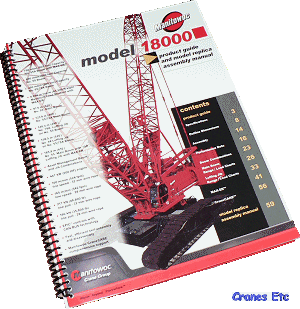 | | The manual does the model justice. | 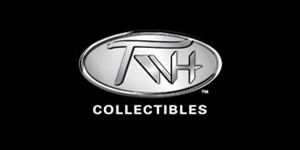 | 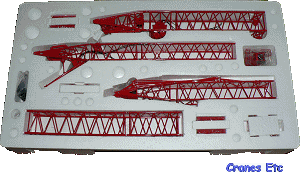 | | Top layer of the huge box. | 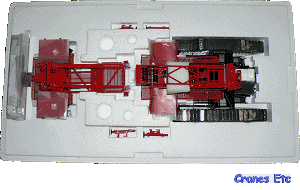 | | Bottom layer, toolkit on the left. | 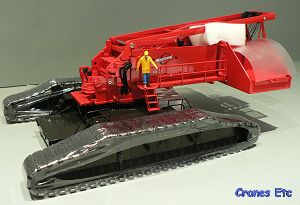 | | The model is well protected when it comes out of the box. The moving mast (lying flat on top) is already reeved. | 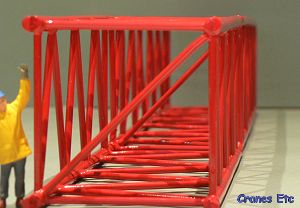 | | Handmade brass sections are not perfect, with mild curves and kinks present. They are the first sections with internal bracing however. | 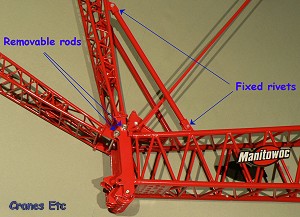 | | If you want to display it without the luffing jib you have to remove the lower fixed rivets shown above. | 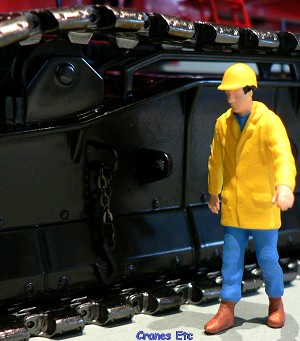 | | Tracks are excellent and are complete with lifting chains on the frames. | 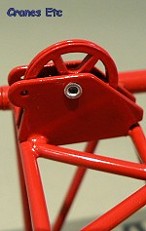 | | Spoked pulley | 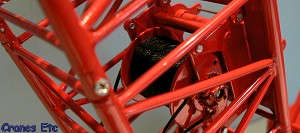 | | Excellent detail at the hoist drums with hydraulic lines. No brakes though! | 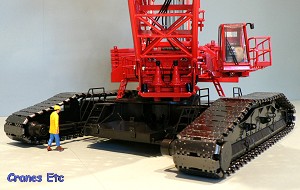 | | This is a big crane. | 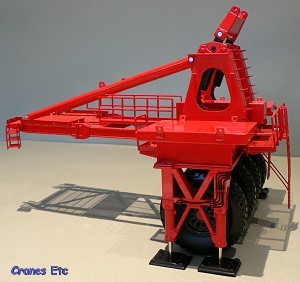 | | MAX-ER attachment has excellent detail - hydraulic hosing and metal rams. | 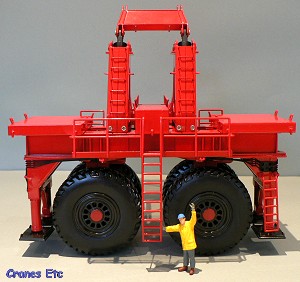 | | 'Come hop on board'. Quality tyres and wheels. |
| The Manitowoc 18000 is a 750 metric tonne (825 US ton) capacity crawler crane, one of the largest in the world. This is the first model of a very large crane mass produced by a model making company other than Conrad. For a relatively new model company such as TWH, it is an ambitious step forward in their product line.
Packaging
The model comes packed in a truly huge box measuring some 77 x 45 x 45cm (30 x 17 x 17in) weighing around 20kg (32lb). An outer plain cardboard box encloses an inner white box which has a simple label on the end.
Inside the box are three separate polystyrene trays holding the many parts of the model. Individual parts are well wrapped with the crane and the MAX-ER counterweight carrier having plenty of protection. It is needed too because the fine details contained on the model inevitably lead to some delicate parts which could be easily damaged. On the review model the packaging looked after the model well, with the only issue needing attention was some of the handrails and ladders which needed to be gently bent back into a true position.
A large 74 page spiral bound manual comes with the model. It is entirely in English so perhaps is not so friendly for collectors in some parts of the world. The manual is essentially in two parts; the first 58 pages are essentially a reprint from Manitowoc product information brochures and the rest is given over to the model assembly instructions. The real crane information in the manual is good as it describes the main components of the machine and gives interesting diagrams showing how the crane is built up on site from the various parts. Also included is a full set of performance data including lifting charts and boom and jib combinations. The assembly instructions contain some high quality pictures of the model including a parts list for the pieces in the box. The only thing missing is a description of the very smallest parts in the model, namely screws and rods used to join some of the main pieces together. As there are subtle differences between some of these parts a novice collector would take time trying to work out what goes where, so a small items parts list would have assisted.
The building of the model is illustrated through nine steps. It is straightforward to follow the sequence although assembly of the boom and jib is complicated by the size of the pieces and a few 'stand back' pictures showing the total model at various stages, not just close ups, would help collectors not used to model building. After completion of assembly the final stage is reeving and for this clear diagrams are provided although as always this part of the process can try the patience, particularly for the multi line main hook. It is pleasing to report that a lot of effort has gone in to providing a quality assembly manual.
However, perhaps in recognition that the manual is not 'alive', TWH have not left it at that. For this model a DVD is also provided to help the collector. It contains film of the model going through its various stages of assembly and this is the most useful part. Reeving is also shown but this adds relatively little to what is in the manual and you could not correctly reeve the model looking at the DVD alone. Also on the DVD are some photos of the real crane and contact details for the model maker. The DVD, although relatively simple, is a worthwhile addition to the model.
Also included in the box is a toolkit in its own plastic carry case. The kit consists of scissors, pliers, screwdriver and tweezers as well as a couple of needles for reeving and a pair of cotton gloves. The kit also includes a tool for operating winches in the crane body. Strangely, the kit also includes 'superglue' but it is not apparent what this is for as it does not seem to be required for assembly. The only thing missing from this kit is some space to keep the smaller parts such as screws should the model not be erected to its maximum capability. The main box also includes a few spare crawler track links.
So, the model includes very comprehensive information and tools to help get the model built, what is it like in practice? The first point to make is that although the model consists of a huge number of separate parts, much of it is already assembled when it is in the box. Boom sections are already joined together, and all the pendant lines are joined up. Only the final connections need to be made. Also the undercarriage and crane body are made up and the moving mast is already reeved. Assembly does not pose much of a problem although fitting together the larger pieces is tricky as some of it is done in the air because some parts are permanently joined when detachable connections would have been better. More on this later.
Detail
This model is very detailed. The undercarriage and crane body are permanently assembled as one piece and although an experienced modeller might want to have a go at taking it to pieces, it is obviously not intended for this. The tracks are metal, and excellent, and one end of each frame is spring-loaded to maintain the tension. The frames are finely detailed with rivets and include a couple of chains with hooks.
Metal steps and handrails rise up to the turntable platform and these are perhaps the best yet seen on a crane model with the walking surfaces consisting of fine mesh grilles. This is a feature which runs throughout the model. Black counterweight slabs fit into trays slung from the under frame. These are well made and are complete with lifting eyes.
The operator's cab is fully detailed with windscreen wipers and grab handles. There is also a door mirror but sadly this is not silvered. The door to the cab is delicate and slides open to reveal a detailed interior complete with the 'Manitowoc' logo printed on the back of the seat. At the rear of the cab various notices are replicated with microscopic writing.
At the front of the crane body two fine slewing motors are modelled complete with lines appearing from their tops. Above these are some connection points for hydraulic hosing which is provided on the boom sections and runs from the winch drums. Moving on around to the side opposite to the operator's cab, there is a hydraulic jack (one of four) which is used to jack the crane body up when installing the under frame. These are modelled here in the usual way with a screw thread and a metal pad foot. Each jack is provided as a separate item which slots into lugs on the crane body. Excellent walkways are provided on each side of the crane.
At the rear of the crane body the crane body counterweight trays hang off each side. They have one slab permanently fixed in each tray which seems a strange modelling decision. The slabs here also include step irons to replicate the ladder formed to allow slinging and unslinging of the slabs.
Looking inside the crane body from above, the level of detail continues. An engine block is present complete with a fan inside a radiator assembly. Remarkably, the fan rotates on the review model. Hydraulic oil and fuel tanks are also modelled and it is here that some of the few plastic parts are found in the shape of exhaust pipes and pipe work.
The boom and jib sections of the crane are hand made of brass. They have a good feel about them with the members being genuine tubes rather than being squared off internally as a result of a die casting process. There is a downside to the hand made pieces however and it is that they are not geometrically perfect. It would seem that the main longitudinal members were set up in a jig and then the bracing attached. It appears that either through not setting the jig up accurately, or because of subsequent cooling, that some slight deformation or kinking is present in some of the sections. This appears when laying sections on a flat surface. On the review model these distortions were present to a degree but the overall effect is slight. However by the nature of hand made work it could be that some collectors will find that jibs or booms have visual twists or bends which might be unsightly. The worst example of this on the review model is the whip line extension at the end of the luffing jib. This shows a clear twist (see photo). In all other respects the lattice sections are very good indeed.
The connections are positive screw joints so there is no fear of the model collapsing. Included detail such as winches are very good and are complete with hydraulic hosing which connects through into the main crane body. Pulleys on the model are first rate as they have spokes and turn freely on their axles. The boom head sports plastic 'Manitowoc' sign boards.
Two hooks are supplied. The main block is large piece with 15 pulleys and a very good swivelling double hook. The whip line is a single metal piece.
The last part of the model is the MAX-ER attachment which is the counterweight trailer. It comes as a single item and continues the first class level of detail of the rest of the model. Walkways and handrails are excellent and the step irons up the frame to the pendant connection point are also impressive. There is some very good hydraulic hosing detail on the legs and the tyres are very good heavy rubber versions. The hydraulic rams for lifting the frame up have metal pistons and pads. The numerous counterweight slabs provided are the same high quality as those used on the crane body.
Features
The crawler tracks work extremely well. The heavy weight of the model combined with the excellent quality means that the tracks move smoothly even on a slippery surface, and, as the links appear to be pinned, they are not susceptible to spring apart.
The crane body features four jacks which are used to lift the crane body during assembly. These drop into slots on the body and as such they are unable to simulate lifting the crane as they would just push themselves out of their slots. However as the model has sadly not been designed to be stripped down to transportable parts, this is not an issue.
To operate the model a tool is provided for the winches in the crane body. The winch drum for the moving mast has a good working brake mechanism. When the tool is pushed in, the drum presses against a spring and away from a brake surface such that it turns freely when the tool is turned. This is a fine system but actually it is unnecessary on the model as supplied since the moving mast is permanently riveted into its final position and cannot be adjusted. Bizarrely the position is reversed on the other drums. They are all free rolling with no brake whatsoever. Collectors will need to chock the drums with a matchstick or similar if they intend to display the model under load - clearly not a satisfactory situation.
The MAX-ER attachment has wheel assemblies which rotate to allow the unit to be towed, or to move in a circle when the crane rotates. The pendant connections at the top of the MAX-ER are spring loaded in order to ensure tension in the pendants. A major feature of large crane models is the ability to rig them in different ways like the real machine and to be able to strip them down to transport-sized pieces for carrying on suitable haulage models. It is in this area that the 18000 is at its weakest. The crane body, under frame and track all come in the box joined as one piece. Although various screws are visible which may enable these parts to be split, clearly the makers do not intend this. Similarly the MAX-ER counterweight carrier is not easily split down.
The position is perhaps even worse with the boom and jib sections. For some inexplicable reason the luffing jib is permanently riveted to the upper boom head so it appears that the model maker has intended that collectors display the model in only one configuration, with a luffing jib, and that is it. Even stranger, it is only one connection that is riveted in this way, with the luffing jib masts readily removable with screwed rods! Fortunately it is not a difficult job to drill out the offending rivets and use small M2 screws instead. The situation is repeated with the moving mast on the crane body which is used to erect the back mast. Again this is permanently riveted to the back of the crane body when, for the provision of a couple of screws, a detachable arrangement could have made this a more flexible model.
Quality
The quality of the casting is pretty much first class with very fine detail appearing throughout the model. Steps, walkways and handrails are all top rate. Boom and jib sections are very good, although as described previously their handmade nature means that the geometry of the parts is not perfect. Pendant bars are all metal and these are so much better than the plastic versions found on other models. The downside here is that they can be bent easily and once bent, they are difficult to get perfectly straight again.
The paintwork and graphics is first class throughout with no areas of missing or poor paint found on the review model.
Price
The model is not cheap and so is far from a casual purchase. Depending on the country, it is around 15% more expensive than the immediately comparable models. The extra cost buys you a superbly presented model with full instructions and tools, and the level of detail sets a new standard for heavy crane models. In consideration of this the 18000 is very good value for money.
Overall
By any standard this is a first class model and is a credit to TWH and Manitowoc. At the time of the model's introduction the level of detail is better than any other mass produced large crane model. This is complemented by an almost complete absence of plastic and the overall feel is of high quality. The comprehensive instructions and accessories provided also sets a new standard. For the heavy crane collector this represents a 'must-have' model.
However, although this model is of a top standard, it is not perfect. The hand made brass boom and jib sections are not geometrically to quite a good enough tolerance so certain combinations of sections could result in a boom or jib which is twisted or curved. In this sense die cast sections are superior. The winch drums certainly should have some kind of braking mechanism. Also the dedicated crane enthusiast will be frustrated that TWH have decided to make a model that, out of the box, can only be configured one way and that is with a luffing fly jib. With a little modification the fly jib can be removed, but how much better the model would be if it could be stripped down to components for transport so that the display options are multiplied. Overall, despite the reservations, this is an excellent model fully deserving of a high score in the model review ratings.
Footnotes
The model was displayed at the Nuremberg Toy Fair in February 2005 as a pre-production prototype, and later that year at ConExpo. Deliveries to customers commenced in September 2005. The model manufacture required 35 diecast moulds, 9 plastic moulds and 35 stamping tools to make over 700 parts that comprise the whole model. A separate extension kit consists of three and a half sections of both boom and jib, with pendant bars. These were produced in Manitowoc red in a run of 900 sets. The versions produced were as follows Manitowoc Red - run of 1950; All Erection (red) - run of 350; Aguado (white body and red) - run of 350; Demont (red body and white) - run of 350; Lampson (blue) - run of 500.
A further run of 300 units of the model was made in 2012 and it had diecast boom sections instead of brass. It is reviewed here.
|
| |
| 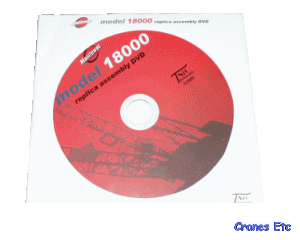 | | Now for the first time you can see the film of the crane.... on the DVD. | 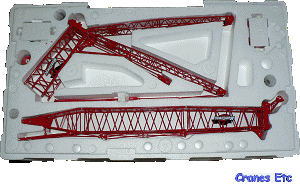 | | Second layer. |  | | A full toolkit is provided. | 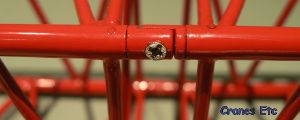 | | Connections are screwed - positive and strong. | 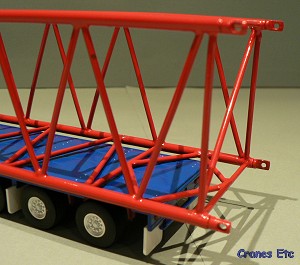 | | Boom section looks good on the Talbert Trailer. | 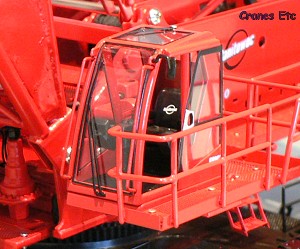 | | Cab detail is top notch with a sliding door and the name printed onto the operator's seat. | 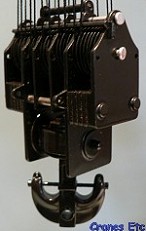 | | Quality hook. | 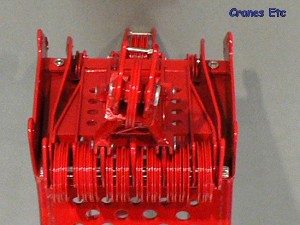 | | Luffing jib head. Whip line head was not made using a jig so the geometry is twisted and poor. | 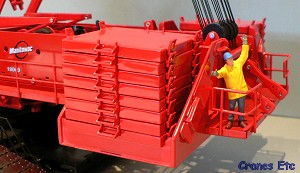 | | At the back, ballast weights are very good and hand railing and walkways are first class. | 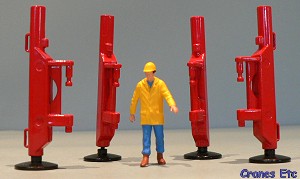 | | 'I'm surrounded by Manitowoc robots!'. The crane body jacks slot into the body, but cannot lift the crane. | 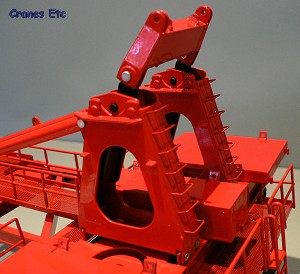 | | Spring loaded pendant connection. Excellent step irons. | 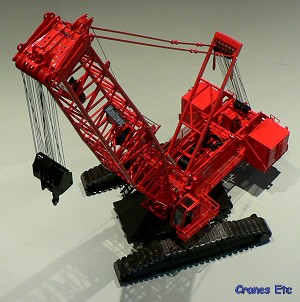 | | Overall impression is that this is a first class model. |
|

